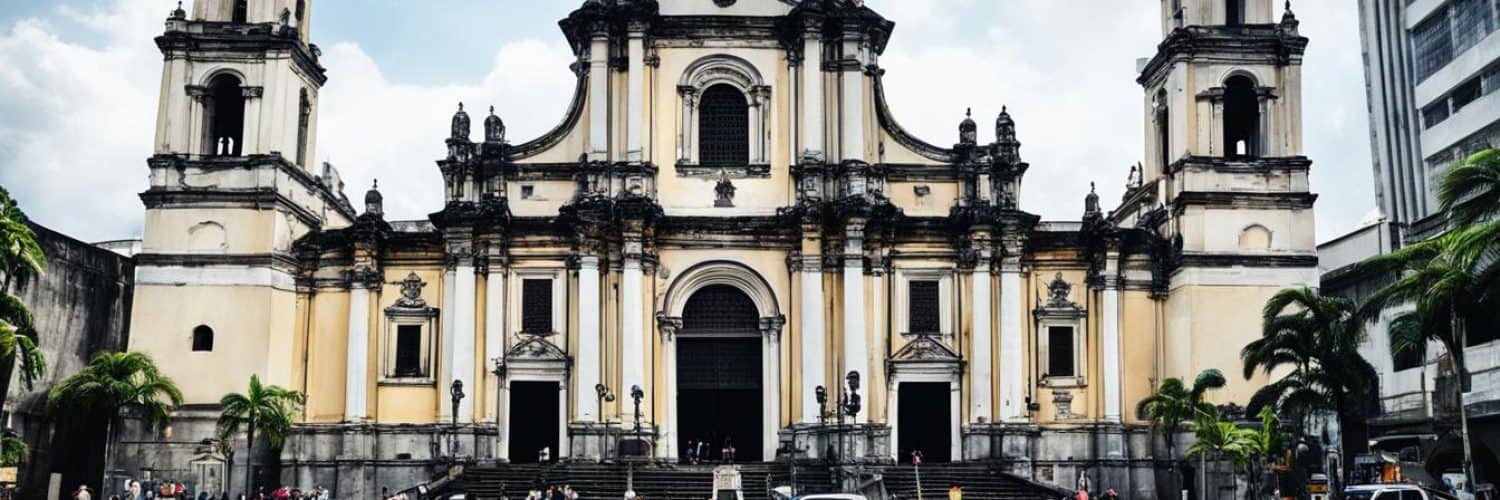Located in the walled neighborhood of Intramuros in Manila, San Agustin Church is a true historic gem that showcases the rich history and exquisite architecture of the Philippines. Completed in 1589 by Miguel Lopez de Legazpi, this stunning stone church is the oldest in the country and has been recognized as a UNESCO World Heritage site. The church’s architecture and intricate details, such as chandeliers, 3-D painted ceilings, and a beautiful second-floor balcony, make it a must-visit destination for architecture enthusiasts and history buffs alike.
San Agustin Church also serves as an archival museum, allowing visitors to explore various religious artifacts that showcase the country’s rich cultural heritage. From ecclesiastical vestments to ancient documents, the San Agustin Museum offers a fascinating glimpse into the history of Christianity in the Philippines. The museum’s architecture, with its arched galleries and stone floors, adds to the overall historical ambiance.
For those seeking a deeper understanding of the church’s historical importance, guided tours and educational programs are available. These programs provide valuable insights into the role of San Agustin Church throughout Philippine history, highlighting significant events and figures. Attending a religious service or event at San Agustin Church is also a unique experience, allowing visitors to witness and participate in local Catholic traditions.
With its convenient accessibility and proximity to other historic attractions in the Intramuros district, such as Fort Santiago and Manila Cathedral, San Agustin Church offers a comprehensive experience that reflects the diverse cultural tapestry of the Philippines. A visit to San Agustin Church is a journey into the past, an opportunity to appreciate the country’s rich heritage and architectural resilience.
Key Takeaways:
- San Agustin Church is a historic gem in Manila, showcasing Spanish architecture and rich history.
- The church’s architecture features intricate details, stunning frescoes, and a grand altarpiece.
- The San Agustin Museum houses a collection of religious artifacts that span from pre-colonial times to the present.
- Guided tours and educational programs provide insights into the church’s historical significance.
- San Agustin Church is an active religious center, hosting weddings and other Catholic traditions.
Architecture and Design of San Agustin Church
San Agustin Church is a true masterpiece of architectural design, showcasing the beauty of Baroque style. The church’s facade is a sight to behold, adorned with intricate carvings and characterized by a two-tiered structure supported by majestic columns. The attention to detail is evident in every element, from the delicately crafted statues to the decorative motifs that embellish the facade.
But the exquisite design doesn’t end there. Step inside the church, and you’ll be greeted by a breathtaking display of trompe-l’oeil murals. These three-dimensional painted ceilings create an illusion of depth, transporting visitors into a world of visual splendor. The frescoes that adorn the walls, the grand chandeliers that illuminate the space, and the antique confessionals all contribute to the grandeur of the interior.
“The architecture of San Agustin Church is truly awe-inspiring. Every detail, from the intricate carvings on the facade to the stunning trompe-l’oeil murals inside, showcases the exceptional craftsmanship of its creators.” – Art Enthusiast Magazine
One of the highlights of the church’s interior is the grand altarpiece, a magnificent centerpiece that commands attention. Elaborately designed and meticulously crafted, it serves as a focal point for both worshippers and art enthusiasts, leaving a lasting impression on all who visit.
San Agustin Church’s architecture and design represent a remarkable blend of artistic vision and engineering prowess, creating a space that captivates the senses and evokes a sense of wonder.
Architectural Highlights:
| Architecture Feature | Description |
|---|---|
| Facade | An ornate facade with intricate carvings, a two-tiered structure, and columns. |
| Trompe-l’oeil Murals | Three-dimensional painted ceilings that create an illusion of depth. |
| Interior Decor | Stunning frescoes, grand chandeliers, and antique confessionals. |
| Grand Altarpiece | A magnificent centerpiece that serves as a focal point for worshippers and art enthusiasts. |
San Agustin Museum: Exploring Religious Artifacts
Adjacent to San Agustin Church is the San Agustin Museum, a must-visit attraction for those interested in exploring religious artifacts. The museum houses an extensive collection of Filipino religious art, spanning from pre-colonial times to the present. Visitors can discover ecclesiastical vestments, ancient documents, colonial furniture, and other artifacts that tell the story of Christianity in the Philippines.
The museum’s architecture, with its arched galleries and stone floors, adds to the historical ambiance. It’s a fascinating place to delve into the cultural heritage of the country.
| Religious Artifacts | Description |
|---|---|
| Ecclesiastical Vestments | Elegant robes and garments worn by clergy and religious practitioners, showcasing intricate designs and craftsmanship. |
| Ancient Documents | Preserved religious texts, manuscripts, and historical records that shed light on the development of Christianity in the Philippines. |
| Colonial Furniture | Antique furniture pieces used in churches and monasteries during the Spanish colonial period. |
| Filipino Religious Art | A wide range of sculptures, paintings, and artifacts that highlight religious practices and beliefs in the Philippines. |
Exploring the San Agustin Museum provides a unique opportunity to gain insights into the intersection of religion, art, and history in the Philippines.
Guided Tours and Educational Programs
Exploring San Agustin Church on your own can be a fascinating experience, but for those seeking a deeper understanding of its historical importance, guided tours are available. These tours are led by knowledgeable guides who provide insightful narratives about the church’s role throughout Philippine history, highlighting significant events and influential figures. Through their expertise, visitors can gain a comprehensive understanding of the cultural and historical significance of San Agustin Church.
During the guided tours, visitors will have the opportunity to explore different areas of the church, including the stunning interior adorned with intricate details and captivating frescoes. Guides will point out notable features and provide explanations that shed light on the architectural design and symbolism of the church.
Furthermore, the tours offer a chance to learn about the religious artifacts housed in the San Agustin Museum, which is adjacent to the church. With its extensive collection of Filipino religious art, ancient documents, and ecclesiastical vestments, the museum provides a deeper insight into the cultural heritage of the Philippines.
By participating in these educational programs, visitors can enhance their appreciation for San Agustin Church and gain a more holistic understanding of its historical and cultural significance. Whether you are a history enthusiast, an art lover, or simply curious about the rich heritage of the Philippines, the guided tours at San Agustin Church provide an enriching and educational experience.
The Benefits of San Agustin Church Guided Tours:
- Insightful narratives about the church’s historical importance
- Exploration of the stunning interior and intricate details of the church
- Explanations of the architectural design and symbolism
- Opportunity to learn about the religious artifacts in the San Agustin Museum
- Enhanced appreciation for the cultural and historical significance of San Agustin Church
“The guided tour at San Agustin Church allowed me to truly grasp the historical importance of this magnificent landmark. The knowledgeable guide walked us through the different periods of Philippine history, connecting the church to significant events and influential personalities. It was a fascinating journey back in time.” – Visitor testimonial
| Guided Tours Information | Contact Information |
|---|---|
| Tour Duration: | 1 hour |
| Tour Schedule: | Monday to Sunday, 9:00 AM – 5:00 PM |
| Tour Fees: | $10 per person (includes admission to San Agustin Church and San Agustin Museum) |
| Advance Booking: | Recommended, especially during peak seasons |
| Contact Number: | +123 456 7890 |
| Email: | in**@**************ch.com |
Events and Religious Services at San Agustin Church
San Agustin Church is not only a historic monument but also an active religious center. Visitors have the chance to witness and participate in local Catholic traditions by attending religious services or ceremonies held at the church. The church is particularly renowned for its weddings, where couples can exchange vows against the backdrop of its rich historical ambiance. Attending a religious service or event at San Agustin Church provides a unique blend of spiritual and historical experiences.
Religious Services at San Agustin Church
San Agustin Church holds regular religious services throughout the year, inviting both locals and tourists to join in the Catholic traditions. The church offers Masses, sacraments, and other religious ceremonies for worshippers to experience and deepen their faith. Whether you are a practicing Catholic or simply curious about the religious practices in the Philippines, attending a service at San Agustin Church can be a meaningful and enriching experience.
San Agustin Church Weddings
The exquisite beauty and historical significance of San Agustin Church make it a sought-after venue for weddings. Couples who dream of a romantic and timeless setting for their special day can exchange vows within the church’s hallowed halls. The grandeur of the Baroque architecture provides a captivating backdrop for wedding ceremonies, allowing couples to create memories that will last a lifetime. The unique blend of spirituality and history make a San Agustin Church wedding truly unforgettable.
Accessibility to San Agustin Church
San Agustin Church, located within the walled city of Intramuros, is easily accessible for visitors. Whether you’re staying in Manila or exploring the city center, reaching the church is convenient and hassle-free. Here’s how you can access San Agustin Church and make the most of your visit.
Public Transportation
Getting to San Agustin Church is a breeze with various forms of public transportation available:
- Jeepneys: A popular mode of transportation in Manila, jeepneys can take you to Intramuros. Look for routes that pass through the area, and inform the driver that you’re heading to San Agustin Church.
- Taxis: Taxis are a convenient option for those who prefer a direct and comfortable ride. Most taxi drivers are familiar with San Agustin Church, so just provide them with the address.
- Walking: If you’re staying in a hotel in the city center, San Agustin Church may be within walking distance. Enjoy a leisurely stroll through Manila’s streets and immerse yourself in the local ambiance as you make your way to the church.
With these transportation options, reaching San Agustin Church is easy no matter where you’re coming from.
Nearby Hotels
For tourists staying in Manila, there are several hotels situated near San Agustin Church. Here are a few options:
| Hotel | Distance from San Agustin Church |
|---|---|
| Intramuros Suites | 0.3 miles |
| The Bayleaf Intramuros | 0.4 miles |
| White Knight Hotel Intramuros | 0.5 miles |
Finding accommodation near San Agustin Church allows you to easily explore the area and make the most of your visit without worrying about long commutes. These hotels offer comfortable rooms, convenient amenities, and a prime location that puts you just steps away from this historic gem.
Remember to check the schedules for church services or events, as they may affect the visitation hours. With easy accessibility and nearby accommodations, visiting San Agustin Church is a seamless experience for all.
Nearby Attractions in the Intramuros District
While visiting San Agustin Church, take the opportunity to explore other historic attractions in the nearby Intramuros district. This charming district is home to a variety of Intramuros attractions that offer further insights into Philippine history and culture.
Fort Santiago
One of the must-visit attractions in Intramuros is Fort Santiago. This historic citadel played a significant role during the Spanish colonial period and has since been converted into a museum. Visitors can explore its ancient walls, dungeons, and gardens while learning about the country’s tumultuous past.
Rizal Shrine
The Rizal Shrine is another notable site in Intramuros. Dedicated to the national hero, Dr. Jose Rizal, it houses fascinating exhibits and artifacts that shed light on his life and the struggle for Philippine independence. The shrine is located inside the Fort Santiago complex.
Manila Cathedral
Just a short walk from San Agustin Church, the Manila Cathedral is a stunning religious landmark. Also known as the Minor Basilica and Metropolitan Cathedral of the Immaculate Conception, it is one of the oldest cathedrals in the country. The cathedral’s grandeur and intricate design make it a must-see attraction for architecture and history enthusiasts.
Exploring the Intramuros district is like stepping back in time. The cobblestone streets, preserved ruins, and historic sites offer a glimpse into the rich cultural heritage of the Philippines. Don’t miss the chance to visit these nearby attractions during your visit to San Agustin Church.
The Rich History of San Agustin Church
San Agustin Church holds a significant place in the rich history of the Philippines, tracing its origins back to the Spanish colonial era. As the oldest stone church in the country, it stands as a testament to the resilience of Filipino heritage, surviving numerous wars and earthquakes throughout the centuries.
The church’s history dates back to 1572 when it was initially constructed. Over time, it underwent various reconstructions before being rebuilt with brick and stone in 1586. This enduring structure showcases a unique blend of Mexican and Spanish architectural styles, reflecting the influences of the time.
The Spanish colonial era was a defining period in Philippine history, shaping its religious and cultural development. San Agustin Church stands as a symbol of this influential era, encapsulating the period’s grandeur and the evolving relationship between the Philippines and Spain.
With its fascinating history and architectural significance, San Agustin Church continues to be a revered national treasure and a testament to the country’s cultural tapestry.
Important Events in San Agustin Church’s History:
- 1572: Initial construction of San Agustin Church
- 1586: Reconstruction with brick and stone
- 1762-1764: Occupation by the British during the Seven Years’ War
- 1854: Earthquake damages the church, leading to repairs and renovations
- 1970: Declaration as a National Historical Landmark
- 1993: UNESCO World Heritage Site inscription
| Century | Main Historical Events |
|---|---|
| 16th | Construction of the original church |
| 17th | Reconstructions and additions to the church |
| 18th | Occupation by the British |
| 19th | Earthquake damage and subsequent repairs |
| 20th | Recognition as a national landmark and UNESCO World Heritage Site |
San Agustin Church’s history is not just a story of buildings and reconstructions; it represents the endurance of a nation and the preservation of a rich cultural heritage. It is a living testament to the resilience and spirit of the Filipino people.
The Resilience of San Agustin Church
San Agustin Church is not just a magnificent historical structure; it has displayed remarkable resilience throughout its existence. This resilience can be attributed to two notable features incorporated into the church’s design and construction.
Lateral Bays: Interior Buttressing
Unlike many other colonial churches in the region, San Agustin Church includes lateral bays as a form of interior buttressing. These lateral bays provide additional support and stability to the structure, particularly during earthquakes. The strategic placement of these bays enhances the church’s ability to withstand seismic activities and ensures the safety of its occupants. This architectural ingenuity has been instrumental in preserving the church through countless tremors and natural calamities.
Durable Materials and Solid Foundation
The construction of San Agustin Church incorporates durable materials like stone and brick, known for their strength and longevity. This choice of robust materials, combined with a solid foundation, has played a vital role in the church’s survival through time. Despite facing several earthquakes and other natural disasters, San Agustin Church has remained standing, showcasing the resilience of its architectural design.
The San Agustin Church stands as a testament to the ingenuity of its builders and the enduring strength of its construction. Its ability to weather the test of time is a true testament to its architectural resilience.
| Key Features | Resilience |
|---|---|
| Lateral Bays | Enhance stability during earthquakes |
| Durable Materials | Stone and brick withstand natural disasters |
| Solid Foundation | Provides a sturdy base for the structure |
The Architecture of San Agustin Church’s Facade
The facade of San Agustin Church combines various architectural styles, predominantly Baroque with influences from Spanish, Italian, and Chinese designs. Though it may not conform to conventional beauty standards, the facade stands out for its practicality and ability to withstand earthquakes. Key features include a two-tiered structure with columns, intricately carved decorations, and a pediment adorned with a rose window.
The facade incorporates Chinese elements, such as symbolic fu dogs, at the courtyard entrances, adding cultural richness to the overall design. This unique blend of architectural styles and cultural influences makes the facade an exceptional characteristic of San Agustin Church.
The Significance of San Agustin Church in Philippine Architecture
San Agustin Church holds immense significance in Philippine architecture. It is recognized as the first stone church in the country, showcasing the blending of Mexican and Spanish architectural styles. The church’s construction was in accordance with the approved plans from the Royal Audencia of Mexico, as the Spanish settlement in the Philippines was initially controlled by the Spanish authorities in Mexico.
San Agustin Church’s architectural design utilized local resources such as stone and wood, resulting in a durable and visually stunning structure. Its historical and cultural importance is evident in the meticulous craftsmanship and attention to detail displayed throughout the church’s interiors and exteriors.
San Agustin Church’s significance as the first stone church in the Philippines highlights its pioneering role in shaping the architectural landscape of the country. Its design and construction paved the way for the development of subsequent stone churches across the archipelago. The blending of Mexican and Spanish architectural influences further reflects the historical and cultural ties between the Philippines and its colonial past.
The blending of architectural styles in San Agustin Church is a testament to the country’s colonial heritage and serves as a visual representation of the Philippines’ rich cultural tapestry.
| Significance of San Agustin Church in Philippine Architecture | Description |
|---|---|
| First Stone Church | San Agustin Church is recognized as the first stone church in the Philippines, setting a precedent for subsequent stone churches in the country. |
| Blending of Architectural Styles | The church showcases a unique blend of Mexican and Spanish architectural influences, representing the historical and cultural ties between the Philippines and its colonial past. |
| Utilization of Local Resources | The construction of San Agustin Church utilized local resources such as stone and wood, resulting in a durable and visually stunning structure. |
Conclusion
San Agustin Church in Manila is a captivating destination that offers a unique blend of historical and cultural experiences. This historic gem, built in 1589, is the oldest stone church in the Philippines and showcases stunning Spanish architecture. Whether attending a religious service, exploring the San Agustin Museum, or marveling at the detailed interiors, a visit to San Agustin Church is sure to leave a lasting impression.
The rich history of San Agustin Church is evident in its design and artifacts. The intricate Baroque-style architecture, adorned with chandeliers and frescoes, is a visual delight. The adjacent San Agustin Museum houses a diverse collection of religious artifacts, providing insights into the cultural heritage of the Philippines.
A visit to San Agustin Church is a journey through time and a testament to the Philippines’ rich cultural tapestry. The church’s significant historical importance, combined with its grandeur, makes it a must-see attraction for both locals and tourists. Plan your visit to San Agustin Church and immerse yourself in the captivating experience it offers.
FAQ
What is the history of San Agustin Church?
San Agustin Church in Manila has a rich history dating back to the Spanish colonial era in the Philippines. It was completed in 1589 by Miguel Lopez de Legazpi, making it the oldest stone church in the country.
What is the architecture and design of San Agustin Church?
San Agustin Church showcases Baroque-style architecture with intricate carvings, a two-tiered facade, and a stunning interior featuring painted ceilings and frescoes. It is known for its trompe-l’oeil murals and exquisite design.
What can I explore at the San Agustin Museum?
Are there guided tours and educational programs available at San Agustin Church?
Yes, guided tours are available at San Agustin Church. Knowledgeable guides provide insights into the church’s historical importance throughout Philippine history, highlighting significant events and figures.
Can I attend religious services or events at San Agustin Church?
Yes, San Agustin Church is an active religious center where visitors can witness and participate in local Catholic traditions by attending religious services or ceremonies. It is particularly renowned for its weddings.
How accessible is San Agustin Church?
San Agustin Church is located within the walled city of Intramuros and is easily accessible by various forms of public transportation, such as jeepneys and taxis. It is also a short ride or walkable distance from many hotels in Manila’s city center.
What other attractions are near San Agustin Church?
The nearby Intramuros district offers other historic attractions such as Fort Santiago, Rizal Shrine, and Manila Cathedral. Exploring this district provides further insights into Philippine history and architectural wonders.
What is the significance of San Agustin Church in Philippine architecture?
San Agustin Church is recognized as the first stone church in the Philippines and showcases the blending of Mexican and Spanish architectural styles. It is an important landmark showcasing the country’s colonial past.
How has San Agustin Church withstood the test of time?
San Agustin Church is known for its architectural resilience. It incorporates lateral bays for interior buttressing to withstand earthquakes. Additionally, its construction using durable materials like stone and brick has helped it survive multiple wars and earthquakes.
What is the architecture of San Agustin Church’s facade?
San Agustin Church’s facade features a blend of architectural styles, primarily Baroque with Spanish and Italian influences from the Virreinato of Mexico. It includes ornate carvings, a two-tiered structure with columns, and Chinese elements at the courtyard entrances.
Is there an entrance fee for San Agustin Church?
Yes, there is an entrance fee to access the San Agustin Museum, which is located adjacent to the church. The fee helps support the maintenance and preservation of the church and its artifacts.
What can I expect during a visit to San Agustin Church?
A visit to San Agustin Church offers a unique blend of historical and cultural experiences. You can explore the beautiful architecture, attend a religious service or event, learn about the church’s history through guided tours, and appreciate the collection of religious artifacts at the San Agustin Museum.


















Add comment